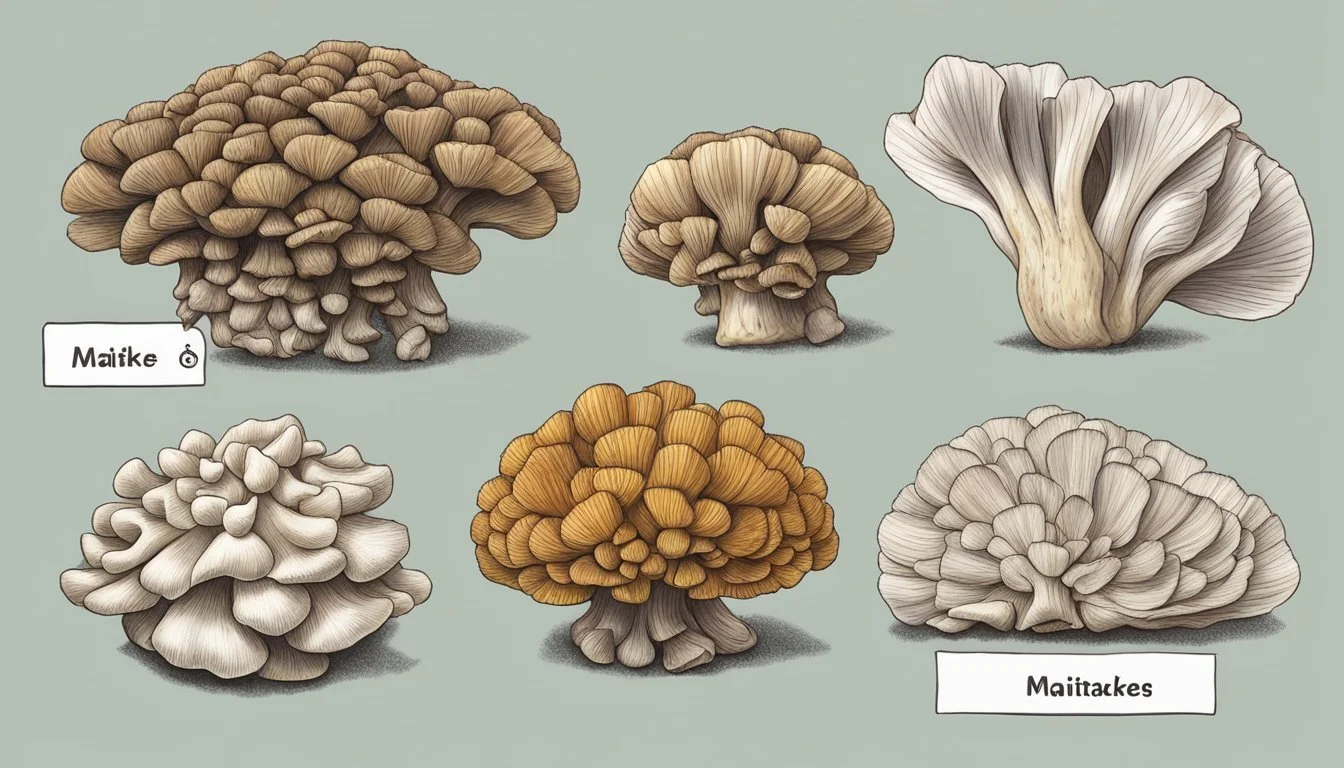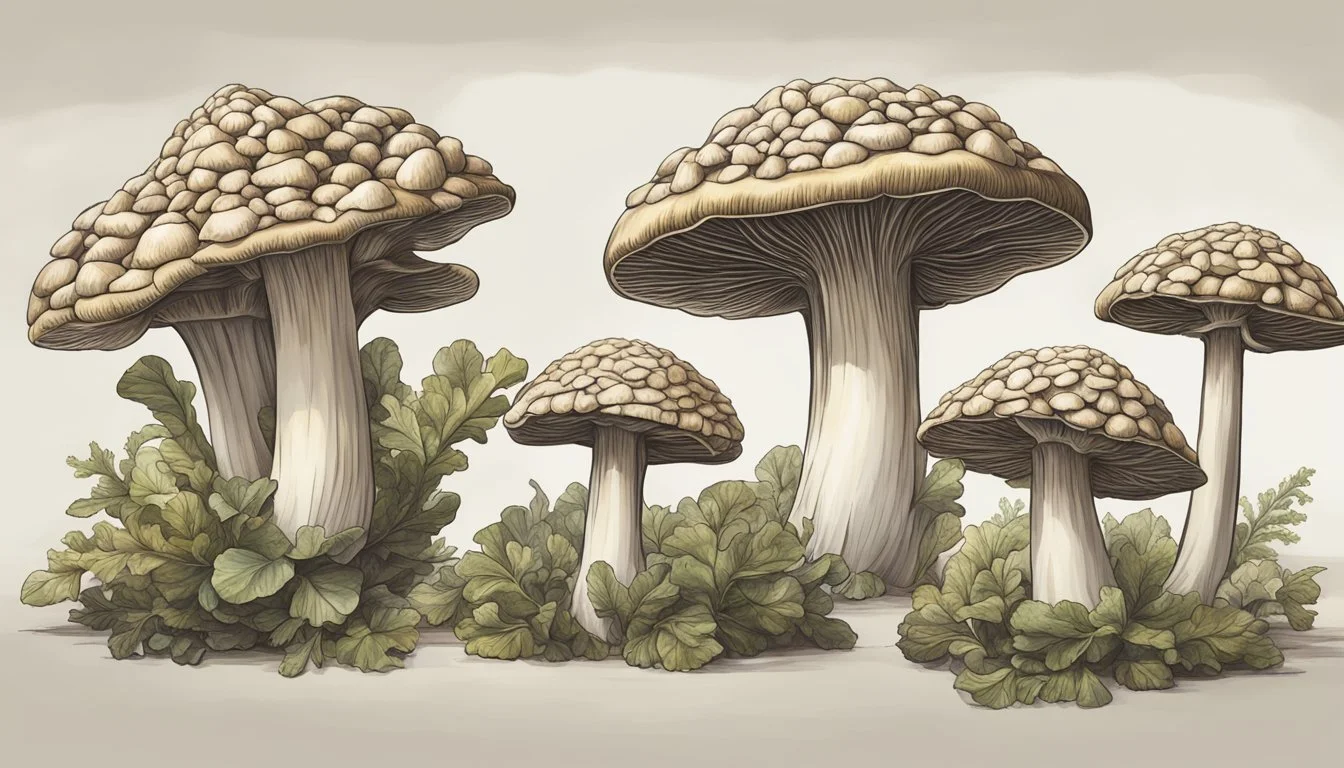How to Substitute Maitake Mushrooms for Shiitake
A Straightforward Guide
Maitake mushrooms (What wine goes well with mushrooms?), with their rich, woodsy taste and delicate texture, offer a distinct profile similar to that of shiitake mushrooms. Commonly used in Japanese and other Asian cuisines, maitake can be a fitting alternative when shiitake mushrooms are unavailable. Both types contribute a depth of flavor to dishes, making them interchangeable in many recipes where mushrooms are not the central ingredient but a complementary one.
While they differ slightly in taste and texture–shiitake mushrooms having a stronger flavor and maitake a milder one–the two can substitute for each other successfully. To effectively use maitake mushrooms in place of shiitake, it is important to consider the role of the mushrooms in the dish. Maitakes are versatile and, when cooked, their edges caramelize and crisp up, similar to the way shiitakes do, thus adapting well in recipes that require such a texture.
The approach to substituting maitake for shiitake should be thoughtful. One should take into account the flavor balance of the other ingredients in the dish to ensure the maitake mushrooms complement the overall taste. In most cases, a simple one-to-one substitution works, especially in cooked recipes such as soups, stir-fries, and stews where mushrooms are sautéed or simmered.
Understanding Mushrooms
Mushrooms such as shiitake and maitake are favored in various cuisines for their unique flavors and textures, as well as their nutritional benefits, offering a wealth of options for those on vegan or vegetarian diets.
Distinctive Qualities of Shiitake and Maitake Mushrooms
Shiitake mushrooms are known for their rich, earthy flavor and a meaty texture, which have made them a popular ingredient in Asian dishes. They typically have an umbrella-shaped cap with a spongy underside where the spores are contained.
Maitake mushrooms, also referred to as Hen of the Woods, have a more delicate taste and a frilly appearance. They boast a woodsy and earthy profile with a fibrous texture, allowing them to take on the flavors of the dish they are included in. This characteristic makes them suitable for a wide range of recipes, mirroring the culinary versatility of shiitakes.
Nutritional Profiles and Health Benefits
Shiitake and maitake mushrooms offer impressive nutritional profiles, both being excellent sources of B vitamins, minerals, and fiber, with relatively low calories. Here is a comparison of their nutritional content (per 100 grams):
Shiitake Mushrooms Maitake Mushrooms Calories 34 kcal 31 kcal Fiber 2.5 g 2.7 g B Vitamins Rich in B2, B3, B5, B6 Rich in B2, B3, B5 Minerals Iron, Copper, Zinc Iron, Copper
Both types of mushrooms are celebrated for their potential health benefits. They are known to contain compounds that can boost immune function and offer cardiovascular support. The protein content in these mushrooms, along with their rich flavor and texture, makes them a favorable choice for those following a vegan or vegetarian diet as they can serve as a meat substitute. Furthermore, their contribution of essential minerals such as iron and copper complements a balanced diet.
Culinary Uses of Mushrooms
Mushrooms like shiitake and maitake have distinctive flavors and textures making them staples in various recipes, particularly in Asian and European cuisines.
Common Dishes Featuring Shiitake and Maitake
Shiitake and maitake mushrooms are prominent in a myriad of dishes due to their rich and savory umami character.
Soups: Both mushrooms are commonly found in broths. Maitake contributes a woodsy flavor and shiitake provides a smoky touch.
Stir-fries: The mushrooms' ability to soak up sauces makes them ideal for Asian stir-fried recipes.
Stews: Their meaty textures are a robust addition to hearty stews.
Risotto: Shiitake mushrooms, in particular, are a favored ingredient in this creamy Italian dish for their rich taste.
Sauces: Finely chopped shiitake or maitake can be incorporated into sauces for added depth of flavor.
Cooking Techniques
Both shiitake and maitake mushrooms are versatile and can be prepared using various cooking methods to enhance their natural flavors.
Grilling: Grilled mushrooms develop a smoky flavor and are often served as a side dish.
Frying: Shiitake mushrooms can be thinly sliced and fried until crispy for garnishes.
Roasting: Roasting intensifies the mushrooms' flavor, perfect for adding a punch to salads or as a topping on pizzas.
By employing these cooking techniques, one can harness the distinctive qualities of shiitake and maitake mushrooms to elevate any culinary creation.
Choosing Mushroom Substitutes
When substituting mushrooms, it is essential for cooks to consider both the flavor and the texture of the mushrooms to maintain the integrity of their dish.
Taste and Texture Considerations
The unique qualities of shiitake mushrooms include their earthy umami flavor, which is paired with a meaty texture. Substitutes should ideally mirror these characteristics to achieve a similar taste profile. Meaty flavor, nutty undertones, and a chewy texture are important aspects to replicate. Advanced culinary knowledge dictates that one must assess the flavor strength, the subtlety or intensity of the mushroom's flavor, as well as the texture—whether delicate or firm—when choosing an alternate mushroom.
Alternatives to Shiitake Mushrooms
Portobello mushrooms are a credible stand-in as they share a meaty texture and earthy notes. Cremini mushrooms, also known as baby bellas, bring a similar earth flavor and have a fairly nutty characteristic, suitable for those seeking a mild shiitake substitute.
Oyster mushrooms and king oyster mushrooms offer a more subtle flavor but can adapt well to the surrounding flavors of the dish, allowing for a pleasing umami taste.
Chanterelle mushrooms are known for their delicate and fruitful flavors, with a hint of pepper.
Enoki mushrooms are crunchy and would not match the meaty texture of shiitake, but they can still impart an earthy touch to the dish.
Porcini mushrooms have a strong nutty flavor and can be used dried or fresh, adding a robust flavor profile wherever shiitakes are called for.
It should be noted that while lobster mushrooms have a unique appeal, their taste and texture differ significantly from shiitake mushrooms and are thus less often recommended as substitutes.
Mushroom Type Flavor Description Texture Description Notes on Use as Substitute Portobello Earthy, meaty Firm, chewy Great for mimicking shiitake mushrooms in heartier dishes Cremini Subtly nutty, earthy Similar to portobello Easily accessible and versatile King Oyster Mild, versatile Firm Can caramelize well, offering a texture akin to shiitake Oyster Subtle, absorbs flavors Slightly delicate Good for providing a texture contrast Chanterelle Fruity, peppery, earthy Meaty, firm Use in equal amounts to substitute for maitake Enoki Mild, slightly nutty Crunchy Lacks the meaty texture but adds an earthy tone Porcini Nutty, earthy Chewy Use dried and rehydrated for intensified flavor
Executing the Substitution
When substituting maitake mushrooms for shiitake mushrooms, it is essential to consider how the variation in flavor and texture can affect the dish. Maitake mushrooms can mimic the umami and meaty qualities of shiitake mushrooms but with a milder and more delicate taste profile.
Adjusting Cooking Methods
Soups and Broths: In soups, maitake mushrooms can be used similarly to shiitake mushrooms. They should be added at the same stage of cooking to develop a rich, savory broth.
Stir-Fry: For stir-fry dishes, maitake mushrooms should be sautéed until their edges are slightly caramelized, enhancing their earthy flavor to better match that of shiitake.
Grilling: Maitake mushrooms are more delicate and may cook faster than shiitake. They should be monitored carefully to prevent overcooking when used as a shiitake substitute in grilled recipes.
Flavor Pairing and Balancing
Umami Flavor: Since maitake mushrooms possess a subtle umami flavor, they may be complemented with ingredients like soy sauce or miso to match the robustness of shiitake mushrooms.
Earthy and Savory: When replacing shiitake with maitake, additional herbs or spices that echo the earthy and savory notes, such as thyme or garlic, could be beneficial in maintaining the desired flavor profile.
Meaty vs. Fruity and Peppery: Maitake mushrooms lack the fruity and peppery undertones of shiitake. In dishes where these notes are essential, consider introducing spices like black pepper or paprika to fill the gap.
Where to Find Your Mushrooms
Locating shiitake and maitake mushrooms, or their suitable substitutes, requires a clear understanding of where to shop and what to look for during selection. This section provides pointed advice on sourcing these fungi, whether in stores or in nature.
Grocery Shopping Tips
When searching for shiitake mushrooms or maitake mushrooms at grocery stores, one can often find them in the produce section, particularly in stores with a focus on Asian cuisines. However, availability may vary.
Substitute Mushrooms Inventory:
Substitute Mushroom Availability Section Oyster Mushroom Common Produce Portobello Mushroom Common Produce Porcini Mushroom Less common Produce or Specialty Lobster Mushroom Seasonal and rare Specialty Chanterelle Seasonal Produce or Specialty
It's important to select fresh mushrooms that are firm, plump, and free from damp spots or decay. Substitutes with a similar texture to maitake, such as oyster mushrooms, are commonly available, but for a flavor closer to shiitake, seek out portobello or porcini mushrooms.
Foraging and Selecting Fresh Mushrooms
For those who opt to forage for mushrooms, identifying shiitake or maitake in the wild requires knowledge of their natural environments. Maitake grows at the base of trees, particularly oaks, during the fall season, while shiitake mushrooms are cultivated on hardwood logs.
When foraging, one should always:
Confirm identification with a knowledgeable guide or through reliable sources.
Be aware of lookalikes; chanterelles can be mistook for false chanterelles, and caution is paramount.
Freshness is crucial when handpicking mushrooms. Maitake should look feathery and have a firm texture, whereas shiitake should possess a smooth cap with a distinct umbrella shape. Use these visual cues to ensure the best culinary experience when substituting one mushroom for another.
Incorporating Mushrooms into a Healthy Diet
Mushrooms are lauded for their health benefits and are a versatile ingredient suitable for many diets. They offer a substantial nutritional profile with relatively low calories, making them an excellent option for those mindful of their energy intake.
Nutritional Value of Mushrooms:
Calories: Low-calorie count, ideal for weight management.
Fiber: Good source of dietary fiber, aiding in digestion.
B Vitamins: Contains B vitamins like B6, riboflavin, and niacin, which are essential for energy metabolism and the nervous system.
Minerals: Rich in minerals such as potassium, which is vital for heart health.
Incorporation Tips:
Stir-Frying: Cook mushrooms with a mix of vegetables for a nutrient-packed stir-fry.
Soups: Add mushrooms to soups for an earthy flavor and texture.
Salads: Top salads with sliced mushrooms for an extra dose of fiber and nutrients.
Substitute: Use mushrooms like shiitake or maitake as meat substitutes in recipes to reduce calorie intake while still providing a savory depth.
Mushrooms are not only low in calories but also high in fiber, which can help individuals feel fuller longer. They also contain various B vitamins and essential minerals, contributing to overall health and well-being. For those looking to improve their diet, incorporating mushrooms is a smart choice due to their broad range of health benefits, from boosting the immune system to potentially fighting off infections.
Conclusion
Maitake mushrooms can be a viable substitute for shiitake mushrooms given their availability and adaptability in various recipes. The key to substitution lies in understanding the textural differences and flavor profiles of these fungi. While shiitake mushrooms are known for their rich, umami flavor, maitake mushrooms offer a slightly milder taste with a woodsy note. They are both regarded for their ability to absorb surrounding flavors and add a meaty texture to dishes.
To substitute effectively, chefs should consider the following points:
Flavor Compatibility: Maitake mushrooms have a subtle earthiness that complements dishes commonly calling for shiitake mushrooms.
Texture Considerations: When cooked, maitake mushrooms possess a tender texture, somewhat similar to shiitake, making them a good match for most recipes.
When using maitake mushrooms as a substitute:
Use equal amounts of maitake as you would shiitake.
Adjust seasoning to match the desired flavor intensity, since maitakes are milder.
Sauté maitakes until the edges caramelize to enhance their flavor and maximize the resemblance to shiitake's texture.
By paying attention to these aspects, food enthusiasts can confidently interchange maitake and shiitake mushrooms in various culinary applications.







